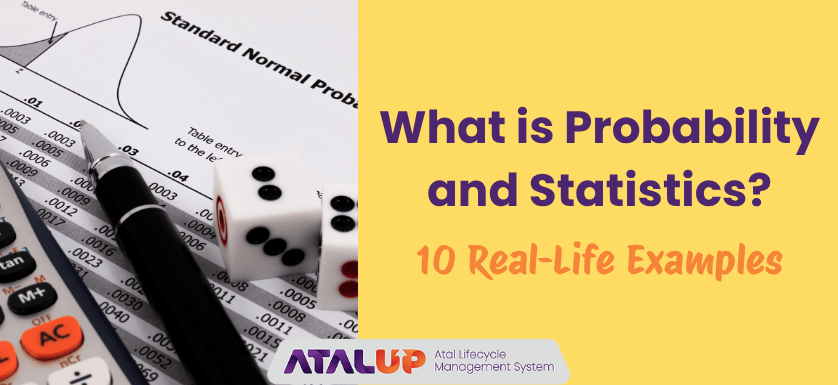
In simple terms, probability and statistics are branches of mathematics that help us understand uncertainty and make sense of data.
Probability is about chances. It tells us how likely something is to happen. For example, what’s the chance it will rain tomorrow?
Statistics is about data. It helps us collect, organize, and study information to understand patterns and make decisions.
Together, statistics and probability help us make predictions, solve real-life problems, and make better decisions in science, health, sports, finance, and even daily life.
These two are not just math concepts; they are tools we use every day without even realizing it!
10 Real-Life Examples of Probability and Statistics
Let’s look at how probability and statistics are all around us.
1. Weather Predictions
When your phone says “80% chance of rain,” it’s not guessing. It’s using data from past weather conditions (statistics) and calculating the chance of rain (probability).
2. Cricket & Other Sports
Team selection, batting order, and match predictions are based on statistics like strike rate, average, and past performance, all mixed with probability to make decisions.
3. Medical Diagnosis
Doctors use probability to estimate the chances of a disease and statistics to track how many people got better after using a medicine. It helps in early detection and better treatment.
4. Traffic Control
Traffic systems use real-time data (statistics) to predict rush hours and control signal timing. Probability is used to estimate traffic flow and possible jams.
5. Insurance Policies
Insurance companies use huge amounts of data to predict risks. Based on your age, health, or job, they use statistics and probability to decide your premium.
6. Exams and Report Cards
From average marks to percentiles and class rank, your school uses statistics. Sometimes, when predicting your board exam result from pre-boards, probability is also used.
7. E-commerce and Recommendations
Apps like Amazon and Flipkart use statistics to understand your shopping habits and show product suggestions using probabilities, based on what people like you usually buy.
8. Tossing a Coin or Rolling Dice
A coin has 2 sides, so the probability of heads or tails is 50%. Dice games, cards, and even online games use these basic rules of chance.

9. Voting & Surveys
Election results and opinion polls are based on public surveys. These use statistics to analyze responses and probabilities to predict winners.
10. Business Decisions
From launching a product to pricing strategy, businesses use data and probabilities to decide what will work. This helps reduce risks and increase profits.
Why Students Must Learn Probability and Statistics
- It builds logical thinking
- It improves decision-making skills
- It connects math with real-life scenarios
It helps students in competitive exams, research, and future careers in data science, AI, business, and more
Sadly, most students only learn formulas, not the fun, practical side. That’s where hands-on learning can make a big difference.
How Atal Tinkering Labs Bring These Concepts to Life
Atal Tinkering Labs (ATLs) are innovation spaces in schools where students from Class 6 to 10 learn STEM (Science, Technology, Engineering, and Math) through hands-on activities.
In an ATL, students explore statistics and probability not just through theory but with real-world tools:
Examples of ATL Activities Around Probability and Statistics:
- Creating their own survey to find the most liked food items in school, collecting data, and drawing bar graphs
- Using dice and coins to understand outcomes, randomness, and probability
- Building a random number generator using microcontrollers like Arduino or Micro:bit
- Analysing data from a small school science fair to find trends and improve future events
- Making games with probabilistic outcomes using logic and coding
This makes learning interactive, meaningful, and unforgettable.
How ATALUP is Supporting Schools Across India
Not every school has the resources or guidance to build and run an ATL effectively. That’s why ATALUP was created: to help schools get access to quality ATL implementation and STEM learning.
Here’s how ATALUP helps:
ATL Application Support
ATALUP helps schools check eligibility and apply for the ₹20 lakh government grant. It simplifies the process and helps with document preparation and submission.
Is your school eligible for
Atal Tinkering Lab
ATL Setup
From choosing the right vendors to getting the lab installed as per NITI Aayog guidelines, ATALUP supports a complete lab setup.
ATL Execution
We help schools create ATL calendars, teacher SOPs, and activity schedules that include topics like statistics and probability, ensuring structured learning.
ATL Tracking and Reporting
ATALUP also helps in measuring ATL lab usage, student participation, and generating real-time reports for audits or NITI Aayog submissions.
ATALUP’s STEM App – Learning Beyond the Classroom
For students who don’t have ATL access or want to practice more at home, ATALUP’s STEM Mobile App is a game-changer.
It offers:
- A 21-day STEM Challenge where students perform simple experiments using household materials
- Activities related to probability and statistics, and Math concepts
- Leaderboards, MCQs, and certificates to keep students motivated
- Easy explanations, guided steps, and real-world logic for each topic
This app ensures that STEM learning is not limited to the lab. It reaches every student, everywhere.
Download the app now
Android: Play Store and iPhone: Apple Store
Final Thoughts
Probability and statistics are not boring math topics. They are life tools. They help students understand patterns, make smarter decisions, and solve real-world problems creatively.
Thanks to Atal Tinkering Labs and platforms like ATALUP, more students across India are exploring these exciting concepts through hands-on learning.
If your school is ready to unlock the power of STEM, ATL Labs and the ATALUP ecosystem are the perfect place to start.